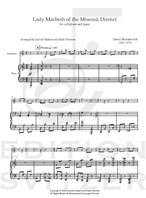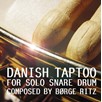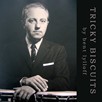
Lady Macbeth of the Mtsensk District
Composer: Dmitrij Sjostakovitj
Instrument: Xylophone and Piano
Level: Intermediate/Advanced
Published: 2020
Price: €20.00
Item details
-
Description +
-
Duration: 4 min.
Arranged by Laurids Madsen and Mads Drewsen
Preface
The xylophone part from Shostakovich opera Lady MacBeth of the Mtsensk District presents a major challenge for the xylophone player, and this arrangement features some of the main parts accompanied by the piano. To create a flow in the music, we have composed musical links between the sections. The cadenza in the middle of the arrangement is composed around different motives and lines from the opera. The project was created as a teacher-student project back in 2015, with the idea to arrange a piece for xylophone and piano, suitable for both auditions and recitals.
-
-
Instrumentation +
-
Xylophone and Piano
-
-
About the composer +
-
Dmitri Dmitriyevich Shostakovich was a Russian composer and pianist. He is regarded as one of the major composers of the 20th century, with a unique harmonic language and a historic importance due to his years of work under Stalin.
-
-
Reviews +
-
Review (Percussive Notes, October 2021)Are there any xylophone solos with piano accompaniment that are not rags? Not many come to mind. Very little has been written for this instrument outside of that genre. Danish percussionists Laurids Madsen and Mads Drewsen have helped fill this hole in the repertoire with this arrangement from a Shostakovich opera.All the major sections of this solo are based on xylophone parts and thematic material of the opera Lady Macbeth of the Mtsensk District. This includes excerpts from the second Intermezzo of Act I and the fourth Interlude of Act III. Through eliminating large chunks of rests and writing necessary musical links that stay true to the original character of the source material, the arrangers have created a legitimate solo work that is about four minutes long.The challenges that arise in the context of the opera have been carried over to this solo arrangement — namely, the speed of certain chromatic gestures, sudden leaps in register, and syncopated entrances of melodic material. These challenges are slightly compounded from the original since the rests have been replaced with either repetitions or amendments to the original excerpts. There is also a cadenza based on some of the motivic material from the opera. This section gives the performer an opportunity to display virtuosity with these lines and their accuracy as the player cruises through arpeggios and chromatic motion that spans the entire range of a 3.5-octave xylophone.This is a wonderful addition to the xylophone solo repertoire. It gives a percussionist the ability to program a piece on this instrument without feeling required to do a rag. This is not to put down that genre by any means, but our choice of keyboard instrument should not dictate the style of music we play. With Madsen and Drewsen’s efforts, we now have something else to present in recitals on the xylophone. This composition will be enjoyed by percussion soloists and orchestral xylophone players alike.
—Kyle Cherwinski
-
-
Credits +
-
Front Cover graphics and layout: Ronni Kot Wenzell
Engraving: CPH Engraving
Printed in Copenhagen, Denmark
Copyright © Mads Drewsen and Laurids Madsen
www.editionsvitzer.com
-












